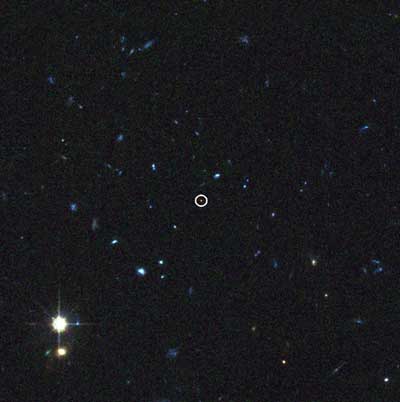Astronomers using the Hubble Space Telescope and the Spitzer Space Telescope were able to see some of the first stars formed in some of the most distant galaxies ever seen

Astronomers using the Hubble Space Telescope and the Spitzer Space Telescope were able to see some of the first stars formed in some of the most distant galaxies ever seen. These stars, located in galaxies in the Fornex cluster, are 13 billion light years away from us. – They emitted the light only a few hundred million years after the big bang.
Although they did not have enough time to form, these galaxies appear to be quite old, meaning that the star formation process must have started very early.
The use of the Spitzer photographs was essential because the theoretical predictions regarding the history of star formation in the early universe are still not consolidated. The team, led by Dr. Andrew Bunker of the University of Exeter in the UK, used archive data from the Hubble Space Telescope to identify ancient galaxies suitable for further study. They then analyzed archival infrared photographs taken by the Spitzer telescope, which studies the infrared wavelengths. Since these are distant galaxies, their redshift is such that their normal light reaches us as infrared light.
The area studied included a part of the southern sky known as the Fornax constellation or the Furnace group. "We searched the Hubble data for galaxies that are 95 percent away from the visible universe," explains Bunker. These images are the most sensitive images of the universe to date, and have allowed us to discover the most hollow objects to date. Passing gas clouds have absorbed the visible light they emit long before it reaches Earth, but their infrared light can still be picked up and the colors in the infrared led researchers to believe they were vast distances away.
Confirmation of the findings as to the enormous distance was provided by the 10-meter diameter telescope on Mount Keck in Hawaii, the largest optical telescope in the world. "We proved that these galaxies are indeed among the most distant objects known by using the Keck telescope to image the spectrum," says Dr. Elizabeth Stanway of the University of Wisconsin in Madison.
The spectra taken by Keck show that these galaxies are so far away that light took 13 billion years to reach us. The telescopes showed them as if they had existed when the universe was less than a billion years old, eight billion years before the Sun and Earth formed.
The next step was to learn more about the stars within these distant galaxies by examining the infrared photographs of this region of space taken by Spitzer. The Hubble images tell us about these young stars, but the new infrared images taken by Spitzer give us more information about the light coming from older stars within these galaxies, says Lawrence Eyles, who studied the image of these objects as part of his PhD research at Exeter.
This is particularly important because it tells us that these galaxies were already 300 million years old when the universe itself was a few hundred million years old, so these were the first galaxies to be born, said Michel Doherty from the Institute of Astronomy in Cambridge. The use of Spitzer's images allowed the team to "weigh" the stars in these galaxies, thanks to the study of starlight. It appears that in at least two cases these early galaxies are as massive as the ones we see today, contrary to the theory that the galaxies started out small and grew through collisions and mergers with other galaxies, says Dr. Mark Lacy Lacy of the Spitzer Space Telescope.
"The real puzzle is that these galaxies look quite old when the universe was only 5 percent of its current age
, said Prof. Richard Ellis Ellis of Caltech. This means that star formation had to begin very early in the history of the universe, or much earlier than previously thought.
When the light of these stars was ignited, it ended the dark ages of the universe when the galaxies formed. They also caused the interstellar gas to be illuminated by starlight - a phenomenon now seen as the cosmic background radiation by the WMAP satellite.
